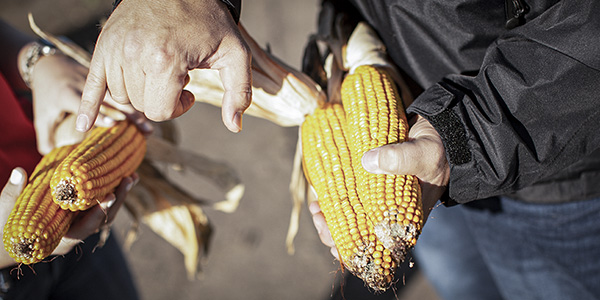AGRONOMICSUPPORT
YOU CAN TAKETO THE FIELD
Corn Research: A Look Behind the Scenes
It’s that time of year. You’re harvesting your crops, watching the yield monitor climb and working day and night to reap the rewards of the tough growing season. But, as you watch your yield monitor this fall, do you know everything that happens behind the scenes to create the high-yielding crop you’re harvesting?
Pre-Commercial Research (PCR) is a term you may have heard of, but not fully understood. A portion of the high yields you’re harvesting can be contributed to PCR trials – the trials that determine which hybrids will make it into the commercial lineup.
AgReliant Genetics uses PCR trials as a high-level, last screening process immediately before a product is commercialized for sale. A PCR trial is the last of six steps a hybrid goes through after an AgReliant corn breeder makes the initial inbred cross to create a hybrid. The process of taking a product from infancy to commercialization takes up to six years, and less than 10% of hybrids that are tested make the cut to proceed into PCR trials, the final step of the research process.
These trials are different from a traditional plot many STAR Partners and farmers have. PCR trials are randomized, replicated three times at every location and scattered across the corn belt, and other corn producing areas, for increased statistical accuracy on the hybrid data. Each entry is four rows wide and 40 feet long. PCR Trials also allow for breeders, researchers, and Technical Team Agronomists (TTAs) to see these products firsthand and make selections based on what growers are expecting in the future of hybrid corn.
TTAs and PCR team members evaluate these plots throughout the season looking at emergence, vigor and late season attributes to determine if they should be selected for commercialization. These new products are compared to our existing commercial lineup to find differences and advantages in things like root scores, kernel depth, kernel rows around, stay green, stalk strength, disease ratings and many other factors which will help decide the products that are offered to your farm in the future.
Currently, the LG Seeds team is completing the annual PCR Tour, which looks at PCR locations across a specific geography. Recently, we completed the Iowa, Wisconsin, and Minnesota PCR Tours. This 1,700 mile journey allowed them to see 738 different four-row entries, and make evaluations on each hybrid in a five day period. Up next is a tour across South Dakota and North Dakota, which will log more than 1,400 miles. After yield data is collected, the LG Seeds team will analyze the current lineup and bring on future high-yielding products that will add value to your farm.
So, as you watch your yield monitor continue to climb this fall, remember what went into that bag of corn before you planted it. It’s a product of one of four corn research programs identifying valuable inbred lines. It’s your local agronomist driving 1,700 miles across the corn belt to rigorously evaluate potential hybrids. It’s Fast Tracking hybrids so you can take advantage of the latest genetics, sooner than ever before. It’s identifying Mix Maker products that solve a specific problem your TTA knows you’re struggling with on your farm. That bag of seed is data and science (and more data) combined with cutting-edge unique genetics and your TTA’s knowledge about your farm.
Want to learn more about what goes into corn research? Head to LGSeeds.com/MixMatters to learn why #MixMatters in corn research.






Technical Team Agronomist